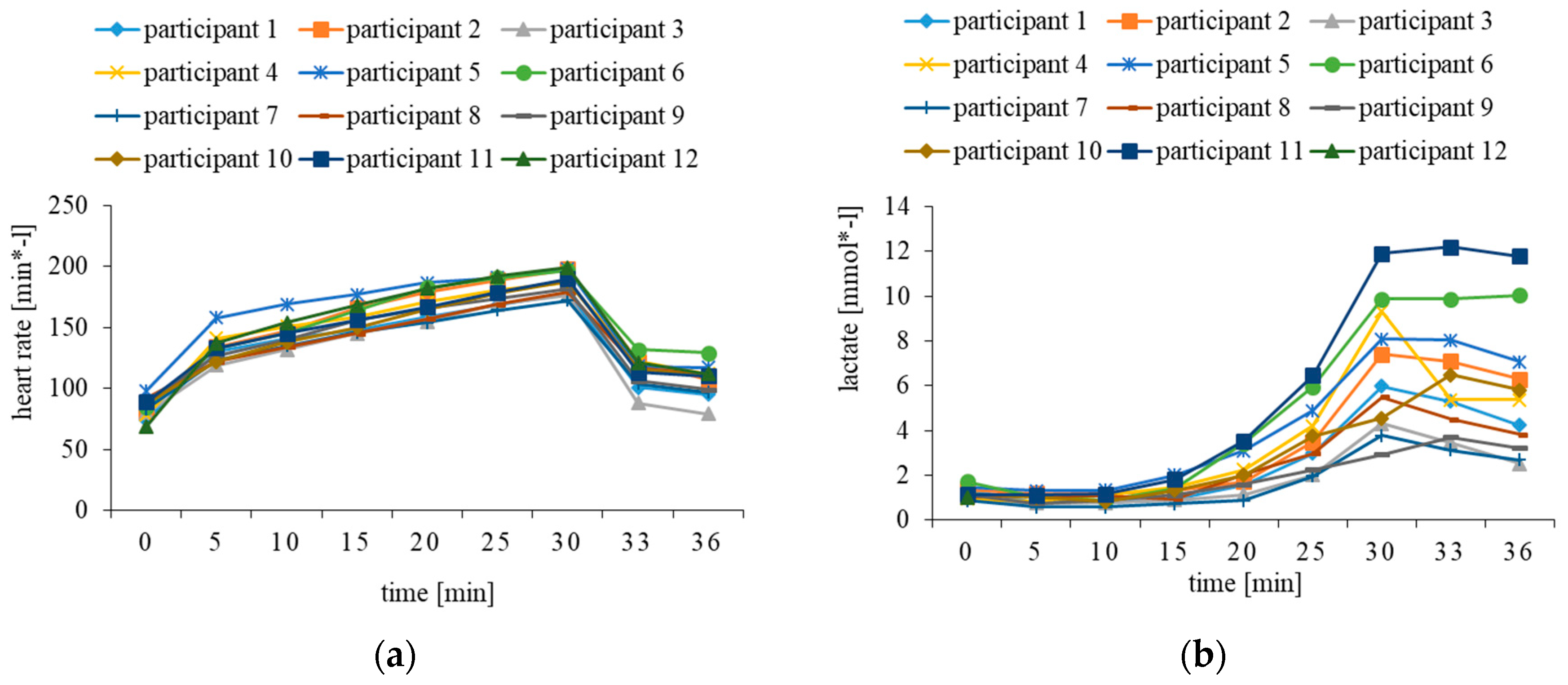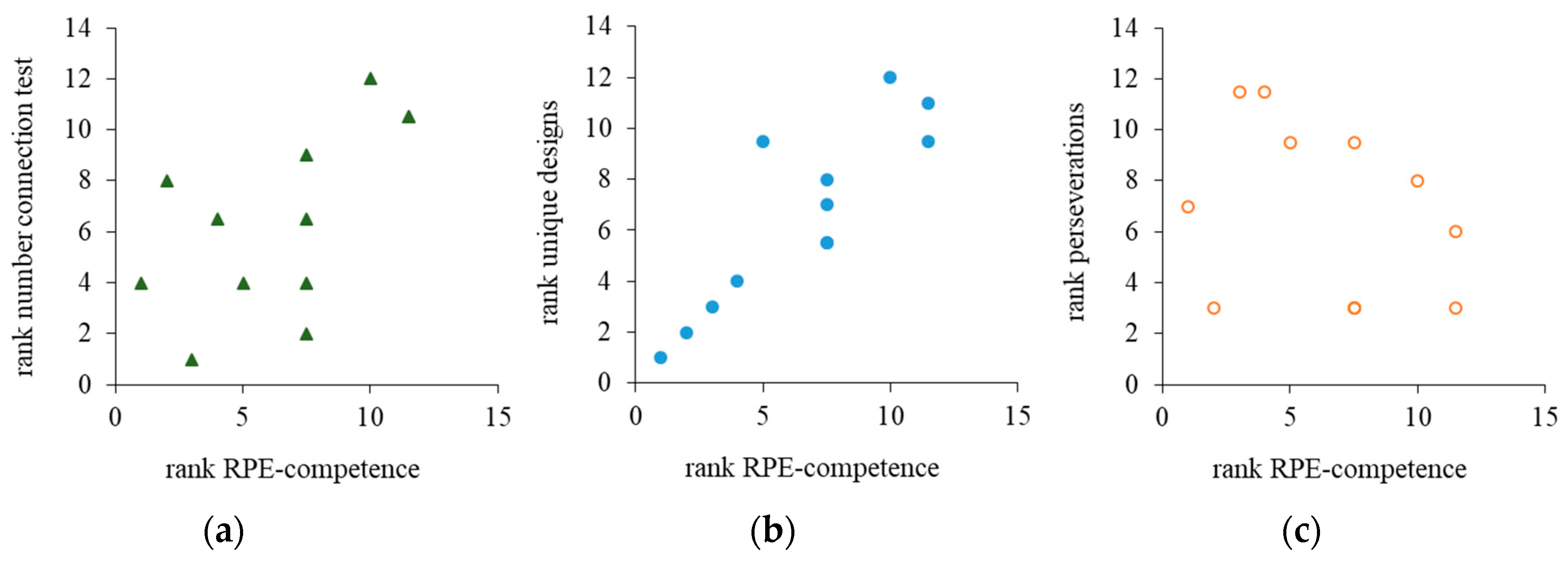Moderators of Perceived Effort in Adolescent Rowers During a Graded Exercise Test
Abstract
1. Introduction
Competence for Rating of Perceived Effort
- The correlation between heart rate and RPE is moderated by the speed of the information processing measured by the Number Connection Test.
- The correlation between heart rate and RPE is moderated by spontaneous and reactive flexibility measured by the Five-Point Test.
2. Materials and Methods
2.1. Procedure
2.1.1. Cognitive Assessment
2.1.2. Exercise Performance test
2.2. Statistics
3. Results
3.1. Graded Exercise Test
3.2. Cognitive Performance Tests
3.3. RPE Competence
4. Discussion
5. Conclusions
Supplementary Materials
Funding
Acknowledgments
Conflicts of Interest
References
- Hallal, P.C.; Victora, C.G.; Azevedo, M.R.; Wells, J.C.K. Adolescent Physical Activity and Health. Sports Med. 2006, 36, 1019–1030. [Google Scholar] [CrossRef] [PubMed]
- Ekkekakis, P. Let them roam free? Physiological and psychological evidence for the potential of self-selected exercise intensity in public health. Sports Med. 2009, 39, 857–888. [Google Scholar] [CrossRef] [PubMed]
- Carl, J.; Sudeck, G.; Pfeifer, K. Competencies for a Healthy Physically Active Lifestyle-Reflections on the Model of Physical Activity-Related Health Competence. J. Phys. Act. Health 2020, 1–10. [Google Scholar] [CrossRef] [PubMed]
- Robinson, L.E.; Stodden, D.F.; Barnett, L.M.; Lopes, V.P.; Logan, S.W.; Rodrigues, L.P.; D’Hondt, E. Motor Competence and its Effect on Positive Developmental Trajectories of Health. Sports Med. 2015, 45, 1273–1284. [Google Scholar] [CrossRef] [PubMed]
- Thiel, C.; Pfeifer, K.; Sudeck, G. Pacing and perceived exertion in endurance performance in exercise therapy and health sports. Ger. J. Exerc. Sport Res. 2018, 48, 136–144. [Google Scholar] [CrossRef]
- St Clair Gibson, A.; Lambert, E.V.; Rauch, L.H.G.; Tucker, R.; Baden, D.A.; Foster, C.; Noakes, T.D. The role of information processing between the brain and peripheral physiological systems in pacing and perception of effort. Sports Med. 2006, 36, 705–722. [Google Scholar] [CrossRef] [PubMed]
- Watt, B.; Grove, R. Perceived exertion. Antecedents and applications. Sports Med. 1993, 15, 225–241. [Google Scholar] [CrossRef] [PubMed]
- Borg, G.A. Psychophysical bases of perceived exertion. Med. Sci. Sports Exerc. 1982, 14, 377–381. [Google Scholar] [CrossRef] [PubMed]
- Groslambert, A.; Mahon, A.D. Perceived exertion: Influence of age and cognitive development. Sports Med. 2006, 36, 911–928. [Google Scholar] [CrossRef] [PubMed]
- Whitt-Glover, M.C.; Taylor, W.C.; Floyd, M.F.; Yore, M.M.; Yancey, A.K.; Matthews, C.E. Disparities in Physical Activity and Sedentary Behaviors Among US Children and Adolescents: Prevalence, Correlates, and Intervention Implications. J. Public Health Policy 2009, 30, S309–S334. [Google Scholar] [CrossRef] [PubMed]
- Elsangedy, H.M.; Krinski, K.; Costa, E.C.; Haile, L.; Fonteles, A.I.; Timossi, L.D.S.; Gregorio da Silva, S. The rating of perceived exertion is not different at the ventilatory threshold in sedentary women with different body mass indices. J. Exerc. Sci. Fit. 2013, 11, 102–106. [Google Scholar] [CrossRef]
- Scherr, J.; Wolfarth, B.; Christle, J.W.; Pressler, A.; Wagenpfeil, S.; Halle, M. Associations between Borg’s rating of perceived exertion and physiological measures of exercise intensity. Eur. J. Appl. Physiol. 2013, 113, 147–155. [Google Scholar] [CrossRef] [PubMed]
- Coquart, J.-B.; Tourny-Chollet, C.; Lemaitre, F.; Lemaire, C.; Grosbois, J.-M.; Garcin, M. Relevance of the measure of perceived exertion for the rehabilitation of obese patients. Ann. Phys. Rehabil. Med. 2012, 55, 623–640. [Google Scholar] [CrossRef] [PubMed]
- Demello, J.J.; Cureton, K.J.; Boineau, R.E.; Singh, M.M. Ratings of perceived exertion at the lactate threshold in trained and untrained men and women. Med. Sci. Sports Exerc. 1987, 19, 354–362. [Google Scholar] [CrossRef]
- Pereira, G.; Souza, D.M.d.; Reichert, F.F.; Smirmaul, B.P.C. Evolution of perceived exertion concepts and mechanisms: A literature review. Rev. Bras. Cineantropometria Desempenho Hum. 2014, 16, 579–587. [Google Scholar] [CrossRef]
- Schmitz, G. Shaping Motor Behavior on Multiple Levels by Modifying Perceptual Settings; Gottfired Wilhelm Leibniz Universität: Hannover, Germany, 2018. [Google Scholar]
- Lohse, K.R.; Sherwood, D.E. Defining the focus of attention: Effects of attention on perceived exertion and fatigue. Front. Psychol. 2011, 2, 332. [Google Scholar] [CrossRef]
- Schmitz, G.; Meis, J.M.; Hafferkamp, M.; Schmitz, S. Competencies for rating perceived exertion in amateur soccer players with and without intellectual disabilities. J. Appl. Res. Intellect. Disabil. 2019, 33, 248–257. [Google Scholar] [CrossRef]
- Schmitz, G.; Sommer, L. Relevanz kognitiver Kompetenzen für das Anstrengungsempfinden im Sport. BG Beweg. Und Gesundh. 2020, 36, 58–64. [Google Scholar] [CrossRef]
- Anderson, V.; Jacobs, R.; Anderson, P.J. Executive Functions and the Frontal Lobes: A Lifespan Perspective; Psychology Press: New York, NY, USA, 2008; ISBN 978-1-84169-490-0. [Google Scholar]
- Spreen, O.; Strauss, E. A Compendium of Neuropsychological Tests. Administration, Norms, and Commentary; Oxford University Press: Oxford, UK, 1998; ISBN 0-19-510019-0. [Google Scholar]
- Salthouse, T.A. What cognitive abilities are involved in trail-making performance? Intelligence 2011, 39, 222–232. [Google Scholar] [CrossRef] [PubMed]
- Oswald, W.D. Zahlenverbindungstest. 3. Überarbeitete Und Normierte Auflage; Hogrefe: Göttingen, Germany, 2016. [Google Scholar]
- Haid, T.H.; Martl, C.; Schubert, F. Der “HAMASCH 5 Punkt test”. Erste Normierungsergebnisse. Z. Für Neuropsychol. 2002, 13, 233. [Google Scholar]
- Goebel, S.; Fischer, R.; Ferstl, R.; Mehdorn, H.M. Normative data and psychometric properties for qualitative and quantitative scoring criteria of the Five-point Test. Clin. Neuropsychol. 2009, 23, 675–690. [Google Scholar] [CrossRef] [PubMed]
- Tucha, L.; Aschenbrenner, S.; Koerts, J.; Lange, K.W. The five-point test: Reliability, validity and normative data for children and adults. PLoS ONE 2012, 7, e46080. [Google Scholar] [CrossRef] [PubMed]
- Carroll, D.J.; Blakey, E.; FitzGibbon, L. Cognitive Flexibility in Young Children: Beyond Perseveration. Child Dev. Perspect 2016, 10, 211–215. [Google Scholar] [CrossRef]
- Cattelani, R.; Dal Sasso, F.; Corsini, D.; Posteraro, L. The Modified Five-Point Test: Normative data for a sample of Italian healthy adults aged 16–60. Neurol. Sci. 2011, 32, 595–601. [Google Scholar] [CrossRef]
- Cosgrove, M.J.; Wilson, J.; Watt, D.; Grant, S.F. The relationship between selected physiological variables of rowers and rowing performance as determined by a 2000 m ergometer test. J. Sports Sci. 1999, 17, 845–852. [Google Scholar] [CrossRef]
- Otter, R.T.A.; Brink, M.S.; Lamberts, R.P.; Lemmink, K.A.P.M. A New Submaximal Rowing Test to Predict 2000-m Rowing Ergometer Performance. J. Strength Cond. Res. 2015, 29, 2426–2433. [Google Scholar] [CrossRef]
- Ingham, S.; Whyte, G.; Jones, K.; Nevill, A. Determinants of 2000 m rowing ergometer performance in elite rowers. Eur. J. Appl. Physiol. 2002, 88, 243–246. [Google Scholar] [CrossRef]
- Ingham, S.A.; Pringle, J.S.; Hardman, S.L.; Fudge, B.W.; Richmond, V.L. Comparison of step-wise and ramp-wise incremental rowing exercise tests and 2000-m rowing ergometer performance. Int. J. Sports Physiol. Perform. 2013, 8, 123–129. [Google Scholar] [CrossRef][Green Version]
- Dickhuth, H.H.; Yin, L.; Niess, A.; Röcker, K.; Mayer, F.; Heitkamp, H.C.; Horstmann, T. Ventilatory, lactate-derived and catecholamine thresholds during incremental treadmill running: Relationship and reproducibility. Int. J. Sports Med. 1999, 20, 122–127. [Google Scholar] [CrossRef]
- Hottenrott, K.; Hoos, O.; Stoll, O.; Blazek, I. Sportmotorische Fähigkeiten Und Sportliche Leistungen—Trainingswissenschaft. In Sport: Das Lehrbuch Für Das Sportstudium; Güllich, A., Krüger, M., Eds.; Springer: Berlin/Heidelberg, Germany, 2013; pp. 439–501. ISBN 978-3-642-37546-0. [Google Scholar]
- Bernards, J.R.; Sato, K.; Haff, G.G.; Bazyler, C.D. Current Research and Statistical Practices in Sport Science and a Need for Change. Sports 2017, 5, 87. [Google Scholar] [CrossRef]
- Eston, R.G.; Williams, J.G. Exercise intensity and perceived exertion in adolescent boys. Br. J. Sports Med. 1986, 20, 27–30. [Google Scholar] [CrossRef] [PubMed]
- Pfeiffer, K.A.; Pivarnik, J.M.; Womack, C.J.; Reeves, M.J.; Malina, R.M. Reliability and validity of the Borg and OMNI rating of perceived exertion scales in adolescent girls. Med. Sci. Sports Exerc. 2002, 34, 2057–2061. [Google Scholar] [CrossRef] [PubMed]
- Rodríguez, I.; Zambrano, L.; Manterola, C. Criterion-related validity of perceived exertion scales in healthy children. A systematic review and meta-analysis. Arch. Argent. Pediatr. 2016, 114, 120–128. [Google Scholar]
- Cassady, S.L.; Kaufman, B.A.; Kelly, C.E.; Eisenmann, S.C.; Wentzien, J.M. Validity of a New Perceived Exertion Scale for Children. Cardiopulm. Phys. Ther. J. 1998, 9, 3–8. [Google Scholar] [CrossRef]
- Marriott, H.E.; Lamb, K.L. The use of ratings of perceived exertion for regulating exercise levels in rowing ergometry. Eur. J. Appl. Physiol. Occup. Physiol. 1996, 72, 267–271. [Google Scholar] [CrossRef]
- Stodden, D.F.; Goodway, J.D.; Langendorfer, S.J.; Roberton, M.A.; Rudisill, M.E.; Garcia, C.; Garcia, L.E. A Developmental Perspective on the Role of Motor Skill Competence in Physical Activity: An Emergent Relationship. Quest 2008, 60, 290–306. [Google Scholar] [CrossRef]
- Haible, S.; Volk, C.; Demetriou, Y.; Höner, O.; Thiel, A.; Sudeck, G. Physical Activity-Related Health Competence, Physical Activity, and Physical Fitness: Analysis of Control Competence for the Self-Directed Exercise of Adolescents. Int. J. Environ. Res. Public Health 2019, 17, 39. [Google Scholar] [CrossRef] [PubMed]
- Gioia, G.A.; Isquith, P.K.; Guy, S.C.; Kenworthy, L. Behavior Rating Inventory of Executive Function (BRIEF); Professional Manual; Psychological Assessment Ressources: Lutz, FL, USA, 2000. [Google Scholar]



Publisher’s Note: MDPI stays neutral with regard to jurisdictional claims in published maps and institutional affiliations. |
© 2020 by the author. Licensee MDPI, Basel, Switzerland. This article is an open access article distributed under the terms and conditions of the Creative Commons Attribution (CC BY) license (http://creativecommons.org/licenses/by/4.0/).
Share and Cite
Schmitz, G. Moderators of Perceived Effort in Adolescent Rowers During a Graded Exercise Test. Int. J. Environ. Res. Public Health 2020, 17, 8063. https://doi.org/10.3390/ijerph17218063
Schmitz G. Moderators of Perceived Effort in Adolescent Rowers During a Graded Exercise Test. International Journal of Environmental Research and Public Health. 2020; 17(21):8063. https://doi.org/10.3390/ijerph17218063
Chicago/Turabian StyleSchmitz, Gerd. 2020. "Moderators of Perceived Effort in Adolescent Rowers During a Graded Exercise Test" International Journal of Environmental Research and Public Health 17, no. 21: 8063. https://doi.org/10.3390/ijerph17218063
APA StyleSchmitz, G. (2020). Moderators of Perceived Effort in Adolescent Rowers During a Graded Exercise Test. International Journal of Environmental Research and Public Health, 17(21), 8063. https://doi.org/10.3390/ijerph17218063




